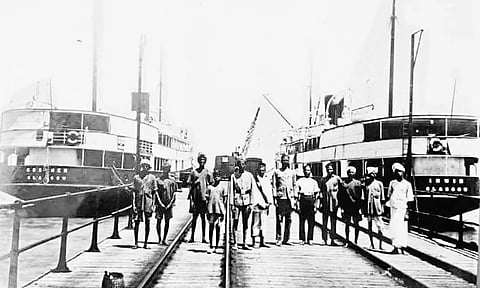

CHENNAI: The Boat Mail was a fascinating train - one can purchase a ticket from Madras to Colombo regardless of the intervening water body - The Park Straight. The train used to depart from Egmore, and travel down south and the final station was alongside a quay. Passengers got down, cleared immigration and customs at makeshift sheds and boarded a ship. Today, the train is called Rameswaram Express, and the boat crossing is no longer functioning.
There was an incident that happened on August 1952. When the Boat Mail reached Manamadurai, passengers in an unreserved compartment complained of a foul smell emanating from the compartment. They got down and noticed a metal trunk under a seat. As expected, the stink came from that box.
The railway police were shocked after opening the box - they found a human body without head. It had been chopped brutally into small pieces to fit inside the box. At the same time, a spherical object covered in a cloth was washed ashore at Royapuram Beach. Fishermen, who opened it, found a severed human head wrapped in the victim’s shirt.
The police also received a complaint from a woman that her husband, an ex-serviceman, Alavandar was missing for a few days. Slowly, the pieces fell into the puzzle.
The head and body were sent for forensic examination. Dr CP Gopalakrishnan, the police surgeon who performed the examination, concluded that both belonged to the same person, a 42-year-old male. Alavandar’s wife identified the body and confirmed it was him. Alavandar had served in the British Indian army as a sub-divisional officer at the Avadi base and his fingerprints were on the file there. That was the conclusive identification. Now, began the hunt for the killer.
After his military service, 42-year-old Alavandar worked in a pen shop on China Bazaar road. He also sold sarees to women on an instalment basis. This led to quite a few extramarital affairs. He was always dressed perfectly with a tie or bow tie and doused in expensive perfume. On inquiry, the police discovered that the deceased had been close to a woman named Devaki Menon. The two had a relationship and she avoided seeing Alavandar after her marriage. Alavandar seems to have been a persistent lover and paid for it with his life. Unable to bear the harassment, Devaki and her husband Prabhakar decided to kill him.
Alavandar was pleasantly surprised when Devaki sent word for him to come to her house. He went to her house on a street called Cemetery Road. He was shocked to see her husband who was present there. The two killed him and decapitated the body to dispose of both parts separately. They fitted the chopped body pieces into a trunk, and took a rickshaw to the Egmore station ahead of departure. They even hired a porter to take the trunk to a third-class compartment and kept it under a seat. When the guard blew the whistle Prabhakar alighted from the moving train.
However, when they heard rumours of an investigation, and when Alavandar’s wife visited them to enquire Devaki about his whereabouts, they got a little worried. They moved to Bombay.
The investigation proceeded at a rapid pace. Devaki and Prabhakar, the prime suspects, were arrested in Bombay. When police raided their house, Prabhakar’s blood-stained palm print was seen on the kitchen wall. And a knife, known as the Malabar knife, was discovered. The rickshaw driver, who dropped Alavandar at Devaki’s house, and the porter at the Egmore railway station who carried the steel box, were traced. Lacking an eyewitness whom they needed to punish Prabhakar, the police attempted to make a deal with Devaki, but she refused.
A jury trial was ordered and it was a huge sensation back then. Govind Swaminathan was the prosecutor (his father had defended the princes in the sensational Delahey murder case). Crowds queued up outside the court to see the proceedings.
The defense argued that there was a lot of provocation on the part of the deceased. To combat the harassment, the murder was committed. Judge Panchapakesa Ayyar seemed to accept the crime as homicide and not a pre-planned murder. He even mentioned Devaki as a victim rather than a criminal. However, when the jury voted them guilty, he gave them light sentences. He gave Prabhakar seven years of imprisonment and Devaki was sentenced to three years in jail. The two united after a few years and migrated to Kerala. It was also reported they had a picture of the judge in their tea shop. This case had its due place in the history of law enforcement, mainly because forensics was used to thwart the criminal’s intent of dispersing the evidence.
— The writer is a historian and an author